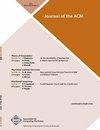Proximity Gaps for Reed–Solomon Codes
IF 2.5
2区 计算机科学
Q2 COMPUTER SCIENCE, HARDWARE & ARCHITECTURE
引用次数: 0
Abstract
A collection of sets displays a proximity gap with respect to some property if for every set in the collection, either (i) all members are δ-close to the property in relative Hamming distance or (ii) only a tiny fraction of members are δ-close to the property. In particular, no set in the collection has roughly half of its members δ-close to the property and the others δ-far from it. We show that the collection of affine spaces displays a proximity gap with respect to Reed–Solomon (RS) codes, even over small fields, of size polynomial in the dimension of the code, and the gap applies to any δ smaller than the Johnson/Guruswami–Sudan list-decoding bound of the RS code. We also show near-optimal gap results, over fields of (at least) linear size in the RS code dimension, for δ smaller than the unique decoding radius. Concretely, if δ is smaller than half the minimal distance of an RS code V ⊂ 𝔽 q n , then every affine space is either entirely δ-close to the code or, alternatively, at most an ( n/q )-fraction of it is δ-close to the code. Finally, we discuss several applications of our proximity gap results to distributed storage, multi-party cryptographic protocols, and concretely efficient proof systems. We prove the proximity gap results by analyzing the execution of classical algebraic decoding algorithms for Reed–Solomon codes (due to Berlekamp–Welch and Guruswami–Sudan) on a formal element of an affine space. This involves working with Reed–Solomon codes whose base field is an (infinite) rational function field. Our proofs are obtained by developing an extension (to function fields) of a strategy of Arora and Sudan for analyzing low-degree tests.Reed-Solomon码的邻近间隙
如果对于集合中的每个集合,(i)在相对汉明距离中所有成员都δ-接近该属性,或者(ii)只有一小部分成员δ-接近该属性,则集合集合就某些属性显示接近间隙。特别地,集合中没有一个集合有大约一半的成员δ——接近属性而其他的δ——远离属性。我们证明了仿射空间的集合相对于Reed-Solomon (RS)码,即使在码维大小为多项式的小域上,也存在接近间隙,并且该间隙适用于任何小于RS码的Johnson/ Guruswami-Sudan列表解码界的δ。我们还展示了接近最优的间隙结果,在RS码维(至少)线性大小的字段上,δ小于唯一解码半径。具体地说,如果δ小于RS码的最小距离V∧q n的一半,则每个仿射空间要么完全δ-接近码,要么至多有(n/q)个部分δ-接近码。最后,我们讨论了我们的接近间隙结果在分布式存储、多方加密协议和具体高效证明系统中的几个应用。我们通过分析Reed-Solomon码(由于Berlekamp-Welch和Guruswami-Sudan)在仿射空间的形式元素上的经典代数解码算法的执行来证明邻近间隙结果。这涉及到使用里德-所罗门码,其基域是一个(无限)有理函数域。我们的证明是通过将Arora和Sudan的一种低次检验分析策略推广到函数域得到的。
本文章由计算机程序翻译,如有差异,请以英文原文为准。
求助全文
约1分钟内获得全文
求助全文
来源期刊

Journal of the ACM
工程技术-计算机:理论方法
CiteScore
7.50
自引率
0.00%
发文量
51
审稿时长
3 months
期刊介绍:
The best indicator of the scope of the journal is provided by the areas covered by its Editorial Board. These areas change from time to time, as the field evolves. The following areas are currently covered by a member of the Editorial Board: Algorithms and Combinatorial Optimization; Algorithms and Data Structures; Algorithms, Combinatorial Optimization, and Games; Artificial Intelligence; Complexity Theory; Computational Biology; Computational Geometry; Computer Graphics and Computer Vision; Computer-Aided Verification; Cryptography and Security; Cyber-Physical, Embedded, and Real-Time Systems; Database Systems and Theory; Distributed Computing; Economics and Computation; Information Theory; Logic and Computation; Logic, Algorithms, and Complexity; Machine Learning and Computational Learning Theory; Networking; Parallel Computing and Architecture; Programming Languages; Quantum Computing; Randomized Algorithms and Probabilistic Analysis of Algorithms; Scientific Computing and High Performance Computing; Software Engineering; Web Algorithms and Data Mining
 求助内容:
求助内容: 应助结果提醒方式:
应助结果提醒方式:


